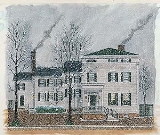
Lee-Fendall House
Encyclopedia
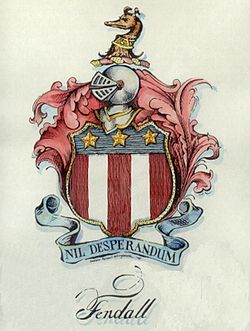
Virginia
The Commonwealth of Virginia , is a U.S. state on the Atlantic Coast of the Southern United States. Virginia is nicknamed the "Old Dominion" and sometimes the "Mother of Presidents" after the eight U.S. presidents born there...
. Since its construction in 1785 the house has served as home to thirty-seven members of the Lee family
Lee family
The Lee family of the United States is a historically significant Virginia and Maryland political family, whose many prominent members are known for their accomplishments in politics and the military. Through the past few hundred years it was believed that Colonel Richard Lee of Virginia descended...
(1785–1903), hundreds of convalescing Union soldiers (1863–1865), the prominent Downham family (1903–1937), and powerful labor leader John L. Lewis
John L. Lewis
John Llewellyn Lewis was an American leader of organized labor who served as president of the United Mine Workers of America from 1920 to 1960...
(1937–1969).
The 1785 house, standing on its original half-acre lot, is in the vernacular "telescopic style" of architecture similar to many Maryland homes, but not found elsewhere in northern Virginia. The house was renovated in 1850, adding Greek Revival and Italianate elements to the original structure.
The historic home is listed on the National Register of Historic Places
National Register of Historic Places
The National Register of Historic Places is the United States government's official list of districts, sites, buildings, structures, and objects deemed worthy of preservation...
for state significance and the Virginia Landmarks Register
Virginia Landmarks Register
The Virginia Landmarks Register is a list of historic properties in the state of Virginia. The state's official list of important historic sites, it was created in 1966. The Register serves the same purpose as the National Register of Historic Places...
, and is a documented contributing feature to the National Historic Landmark District of Alexandria, Virginia. The property is now owned and operated by the Virginia Trust for Historic Preservation and run as a museum to preserve the architectural and historic value of the house and gardens and to spread knowledge and appreciation for Virginian and American history.
The Lee-Fendall House Museum and Garden is open for tours on the hour Wed.-Sat. 10-3, and Sun. 1-3. The House Museum and Garden is also available for private rentals.
Construction
In November 1784, Maj. Gen. Henry "Light Horse Harry" Lee (1756–1818) purchased 3 one-half acre lots in Alexandria from Baldwin Dade (1716–1783), a merchant. On December 4, 1784, he sold one of these tracts to Philip Richard Fendall IPhilip Richard Fendall I
Philip Richard Fendall I was an influential banker, lawyer, and merchant in Alexandria, Virginia. He was a member of the Lee family and a friend and business partner to George Washington...
, Esq. (1734–1805), for three hundred pounds, and Philip began building the Lee-Fendall House, for his second wife, Elizabeth (Steptoe) Lee (1743–1789), in the spring or early summer of 1785. The lot was located on the southeast corner of Washington and Oronoko Street, then the edge of the city. At the time, very few structures were near, and the Fendalls enjoyed a spectacular view of Oronoko Bay and the ships which docked there. To the north and west lay verdant fields of grass and clover. Alexandria was an up-and-coming thriving social and political center in Northern Virginia
Northern Virginia
Northern Virginia consists of several counties and independent cities in the Commonwealth of Virginia, in a widespread region generally radiating southerly and westward from Washington, D.C...
. The architect is unknown, but the style is similar to that found at "Hard Bargain", an estate built by the Digges family, and located in Charles County
Charles County, Maryland
Charles County is a county in the south central portion of the U.S. state of Maryland.As of 2010, the population was 146,551. Its county seat is La Plata. This county was named for Charles Calvert , third Baron Baltimore....
from which Philip hailed. It consisted of a "telescopic" design, which was synonymous with Maryland, and had three sections. A plat on a 1796 insurance policy shows eight buildings on the quarter block, valued at a total of $11,500, including a "Rabbit House" and a "Pigeon House". The main dwelling house was valued at $5,000.
The house was completed by November 1785, when George Washington
George Washington
George Washington was the dominant military and political leader of the new United States of America from 1775 to 1799. He led the American victory over Great Britain in the American Revolutionary War as commander-in-chief of the Continental Army from 1775 to 1783, and presided over the writing of...
wrote in his diary dated November 10, 1785: "Went up to Alexandria to meet the Directors of the Potomack Company and dined at Mr. Fendall's (who was from home) and returned in the evening with Mrs. Washington." The Fendalls are mentioned in Washington's 1785-1786 diaries more than anyone outside his own family, and Washington dined here at least seven times in those years. Elizabeth was a favorite of George and Martha Washington
Martha Washington
Martha Dandridge Custis Washington was the wife of George Washington, the first president of the United States. Although the title was not coined until after her death, Martha Washington is considered to be the first First Lady of the United States...
, a frequent visitor to Mount Vernon
Mount Vernon (plantation)
Mount Vernon, located near Alexandria, Virginia, was the plantation home of the first President of the United States, George Washington. The mansion is built of wood in neoclassical Georgian architectural style, and the estate is located on the banks of the Potomac River.Mount Vernon was designated...
, and frequent hostess to the Washingtons. Philip was one of the few men who were close friends with Washington and participated in his social coterie.
Home of the Lees
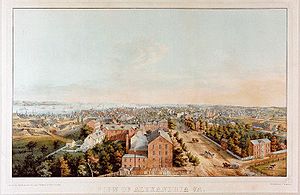
American Revolution
The American Revolution was the political upheaval during the last half of the 18th century in which thirteen colonies in North America joined together to break free from the British Empire, combining to become the United States of America...
, Alexandria, already known as "Washington's Home Town", became known also as the "Home Town of the Lees". At "Lee Corner
Lee Corner
Historic Lee Corner is a section of Old Town Alexandria, Virginia at the intersection of North Washington and Oronoco Street. The corner is named after the Lee family, who once owned almost every property on the intersection...
", the intersection of Washington and Oronoco Streets, stands the "Keystone", the Fendall-Lee House, as it was known. North across Oronoco are twin houses: 609, where Cornelia (Lee) Hopkins (1780–1818), daughter of William Lee
William Lee (diplomat)
William Lee was an American diplomat during the Revolutionary War.-Background:He was born at Stratford Hall Plantation in Westmoreland County, Virginia to Hon. Thomas Lee and Hannah Harrison Ludwell...
(1739–1795), lived after her marriage to John Hopkins (1795–1873) until her death in 1816, and 607, the last home of Light Horse Harry Lee, and known to the public as "Robert E. Lee
Robert E. Lee
Robert Edward Lee was a career military officer who is best known for having commanded the Confederate Army of Northern Virginia in the American Civil War....
's Boyhood Home". Just across Washington Street is the house built by Edmund Jennings Lee I (1772–1843), younger brother of Harry Lee. Directly south of the Fendall-Lee House, on the corner of Washington and Princess, is the house built by Hon. Charles Lee
Charles Lee (Attorney General)
Charles Lee was an American lawyer from Virginia. He served as United States Attorney General from 1795 until 1801....
(1758–1815), Attorney General, another of Harry's brothers. Charles and Edmund married Lee sisters, Anne and Sally, daughters of Richard Henry Lee
Richard Henry Lee
Richard Henry Lee was an American statesman from Virginia best known for the motion in the Second Continental Congress calling for the colonies' independence from Great Britain. He was a signatory to the Articles of Confederation and his famous resolution of June 1776 led to the United States...
(1732–1794). The Lee-Fendall House is the only Lee family house on Historic Lee Corner that is presently a museum.
Light Horse Harry Lee spent a great deal of time with his relatives at the Fendall home. Philip R. Fendall was Harry's cousin and Mrs. Fendall (Philip's second wife), Elizabeth (Steptoe) Lee (1743–1789), was Harry's mother-in-law. Matilda Lee was devoted to her mother, and many of Harry's letters are datelined "Alexandria", indicating he was at 614 Oronoco. Also Washington's diary includes several entries about going to Alexandria and dining at Mr. Fendall's to meet Colonel Lee. Both Mrs. Fendall and Matilda were in failing health in 1788, and the Lees spent the winter of 1788-1789 with the Fendalls. Harry Lee was still at the house in April 1789, when George Washington left Virginia to become President of the United States. Col. Dennis Ramsay, Mayor of Alexandria, asked Lee to write the farewell address for the first President, which the Mayor delivered at the farewell dinner (201 North Fairfax Street) given for Washington by his fellow citizens. A decade later, Harry Lee was serving in Congress when Washington died. The Senate asked Lee to write the eulogy for the first President. It was in that speech that he penned the famous description of George Washington as "first in war, first in peace, and first in the hearts of his countrymen."
Elizabeth Fendall lived in the Lee-Fendall House from 1785 until her death in June, 1789, probably from cancer. She died unexpectedly in May of 1789, while on a trip that was to include a visit to her daughter, Matilda at "Stratford
Stratford Hall Plantation
Stratford Hall Plantation in Westmoreland County, Virginia, was the home of four generations of the Lee family of Virginia, including two signers of the Declaration of Independence, and it was the birthplace of Robert Edward Lee , who became the Confederate General-in-chief during the American...
". Her brother Harry Lee wrote to James Madison
James Madison
James Madison, Jr. was an American statesman and political theorist. He was the fourth President of the United States and is hailed as the “Father of the Constitution” for being the primary author of the United States Constitution and at first an opponent of, and then a key author of the United...
, Jr.: "You have heard of the loss we have met with in the death of Mrs. Fendall - better for her to be sure had this event taken place sooner & altho' we are convinced of this truth yet our affliction is immoderate. Poor Mrs. Lee is particularly injured by it, as the affliction of mind adds to the infirmity of her body." Her daughter, Matilda, was prostrated by the loss of her mother, and the Lees remained in Alexandria many weeks after the funeral.
In 1791, Fendall married for a third time to Harry's sister, Mary "Mollie" Lee (1764–1827). He was now related to Light Horse Harry Lee in three ways: as his cousin, step-father-in-law, and brother-in-law. Fendall died in 1805, but Mary Lee Fendall continued to live in the house with her two children, Philip Richard Fendall II
Philip Richard Fendall II
Philip Richard Fendall II was an American lawyer and politician. He was born December 18, 1794 at the Lee-Fendall House, located at 614 Oronoco St., Alexandria, Virginia. Fendall matriculated to the College of New Jersey, later known as Princeton University in 1812 where he excelled at forensics...
(1794–1868), and Lucy Eleanor Fendall (ca. 1795-1872), until her death in 1827.
In 1811 with the assistance of his sister Mary (Lee) Fendall "Mollie" (1764–1827), General Henry Lee was able to rent the stately house at 607 Oronoco, which was owned by William Henry Fitzhugh
William Henry Fitzhugh
William Henry Fitzhugh was a prominent member of the Virginia constitutional convention of 1829–1830 and an officer of the American Colonization Society....
(1792–1830) (another Lee!). It is certain that Gen. Robert Edward Lee (1807–1870), the son of Henry, was a frequent visitor of his Aunt Fendall's household across the street. The family resided at 607 until Robert left for West Point in 1825. The tragedy of Harry Lee's injuries by a Baltimore mob as he tried to defend a friend who had opposed the War of 1812
War of 1812
The War of 1812 was a military conflict fought between the forces of the United States of America and those of the British Empire. The Americans declared war in 1812 for several reasons, including trade restrictions because of Britain's ongoing war with France, impressment of American merchant...
, and his desperate search for health in Barbados
Barbados
Barbados is an island country in the Lesser Antilles. It is in length and as much as in width, amounting to . It is situated in the western area of the North Atlantic and 100 kilometres east of the Windward Islands and the Caribbean Sea; therein, it is about east of the islands of Saint...
, were too much, and Henry died in 1818.
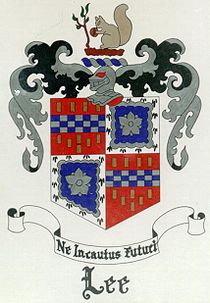
Edmund Jennings Lee
After Mary Lee Fendall's death in 1827, Edmund Jennings Lee IEdmund Jennings Lee I
Edmund Jennings Lee was a prominent legal and political figure in Alexandria, Virginia. He was a member of the Lee family of Virginia and lived for some time at the Lee-Fendall House in Old Town Alexandria, Virginia.-Early Life and Career:...
(1772–1843) bought the house, and leased it for many years. In 1836, he moved from his home on 428 Washington, across the street, and into the Lee-Fendall House. Edmund was a brother of Light Horse Harry Lee. His wife Sally Lee (1775–1837) was the youngest daughter of Richard Henry Lee
Richard Henry Lee
Richard Henry Lee was an American statesman from Virginia best known for the motion in the Second Continental Congress calling for the colonies' independence from Great Britain. He was a signatory to the Articles of Confederation and his famous resolution of June 1776 led to the United States...
(1732–1794), a senator and signer of the Declaration of Independence
United States Declaration of Independence
The Declaration of Independence was a statement adopted by the Continental Congress on July 4, 1776, which announced that the thirteen American colonies then at war with Great Britain regarded themselves as independent states, and no longer a part of the British Empire. John Adams put forth a...
. Sally died here in 1837, and Edmund continued to live here until his death in 1843.
In 1843, two of Edmund J. Lee’s daughters, Hannah (Lee) Stewart (1806–1872) and Sally Lee (1801–1879), inherited the House and leased it to Lucy Lyons Turner. Commonly known as "Aunt Turner", she was the granddaughter of Virginia Supreme Court Justice Peter Lyons
Peter Lyons
Peter Lyons was born in Ireland about 1734. He graduated from Trinity College, University of Dublin. Following this, he came to King William County, Virginia, and studied law under his uncle, James Power. He was admitted to the bar on February 5, 1756, and started to practice law in the county...
and confidante of the Cassius Francis Lee, Sr. (1808–1890) family.
The Cazenove Renovation
In 1850, Louis Anthony Cazenove (1807–1852), a successful Alexandria merchant, bought the Lee family home for his new bride, Harriotte Stuart, daughter of Cornelia Lee Turberville Stuart and great-granddaughter of Richard Henry LeeRichard Henry Lee
Richard Henry Lee was an American statesman from Virginia best known for the motion in the Second Continental Congress calling for the colonies' independence from Great Britain. He was a signatory to the Articles of Confederation and his famous resolution of June 1776 led to the United States...
, signer of the Declaration of Independence
Declaration of independence
A declaration of independence is an assertion of the independence of an aspiring state or states. Such places are usually declared from part or all of the territory of another nation or failed nation, or are breakaway territories from within the larger state...
. The young couple were joined at the house by Louis' daughters from his first marriage, Frances (1838–1884) and Charlotte Louise (1840–1914), and his father Anthony Charles Cazenove (1775–1852), a French Huguenot immigrant from Geneva
Geneva
Geneva In the national languages of Switzerland the city is known as Genf , Ginevra and Genevra is the second-most-populous city in Switzerland and is the most populous city of Romandie, the French-speaking part of Switzerland...
. The Cazenoves renovated the home to include the latest styles and technologies. They added Greek Revival and Italianate embellishments to the original 1785 structure as well as the front and back porches and installed the first heating, plumbing, and servant bell systems in the house.
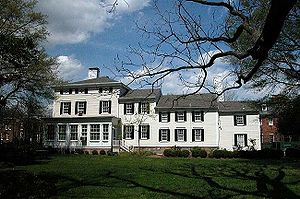
Civil War Experience
When both Louis and A.C. Cazenove died in 1952, Harriotte was left with Louis' two daughters, her infant son, and the house to take care of. In 1856, Harriotte moved her small family to her new country home three miles up the road at Seminary Hill. Named "Stuartland" after her family, the new two-story house had eight rooms, plus a kitchen, and was in a similar telescoping style to the Lee-Fendall House she left. When the Civil WarCivil war
A civil war is a war between organized groups within the same nation state or republic, or, less commonly, between two countries created from a formerly-united nation state....
brought invading forces to Harriott's door, she fled with her son to her mother's home in Chantilly, Virginia
Chantilly, Virginia
Chantilly is an unincorporated community located in western Fairfax County and southeastern Loudoun County of Northern Virginia. Recognized by the U.S. Census Bureau as a census designated place , the community population was 23,039 as of the 2010 census -- down from 41,041 in 2000, due to the...
. Union forces occupied Seminary Hill and probably turned Stuartland into a headquarters. General George McClellan
George McClellan
George B. McClellan was an American Civil War military leader, Presidential candidate and Governor of New Jersey.George McClellan may also refer to:*George McClellan , American physician who founded medical schools...
may have lived in the home prior to the Peninsula Campaign
Peninsula Campaign
The Peninsula Campaign of the American Civil War was a major Union operation launched in southeastern Virginia from March through July 1862, the first large-scale offensive in the Eastern Theater. The operation, commanded by Maj. Gen. George B...
in early 1862.
Harriotte leased the Lee-Fendall House from the time she left Alexandria into the beginning of the Civil War. From 1861-1863, she rented the house to a New York railroad contractor and his family. In 1863, Edwin Bentley, Chief Surgeon of the Military Hospitals in occupied Alexandria, requested "the rebel house opposite Grosvenor hospital" for use as a medical building. He was "granted the authority to take possession of the withnamed house for a general hospital." The Union Army seized the house for unpaid taxes, but offered to return ownership and pay rent if Harriott would swear the Loyalty Oath to the Federal Government. Harriotte refused to swear her loyalty and the house was turned into and annex of the Grosvenor Hospital. Chief Surgeon Bentley likely moved his quarters to the house and it was here that he performed the first successful blood transfusion
Blood transfusion
Blood transfusion is the process of receiving blood products into one's circulation intravenously. Transfusions are used in a variety of medical conditions to replace lost components of the blood...
. Hundred of soldiers recuperated from wounds, surgeries, and illnesses at the house. Those who did not survive were placed in a dead house, or morgue, built at the back of the property.

Fleming Home
Harriotte eventually recovered the house after the war and in 1870, it was bought from the estate of Edmund Jennings Lee I (1772–1843) by Dr. Robert Fleming (d. 1871), who had married Mary Elizabeth Lee (1827–1903), eldest child of Col. Richard Bland Lee II (1797–1875). Dr. Fleming died in 1871, and according to Mrs. James Lee Sheridan, Mrs. Fleming moved to Washington, D.C, and permitted her three sisters, Myra Gaines (Lee) Civalier (1841–1908), Evelina Prosser (Lee) Morgan (1832–1867), Julia Eustis (Lee) Prosser, and one brother, Robert Fleming Lee (1849) to reside at the house. Myra became a prominent actress and outstanding celebrity on the Alexandria social scene in the 1890s and also performed throughout the United States. She married Charles Napoleon Civalier (1836), of BordeauxBordeaux
Bordeaux is a port city on the Garonne River in the Gironde department in southwestern France.The Bordeaux-Arcachon-Libourne metropolitan area, has a population of 1,010,000 and constitutes the sixth-largest urban area in France. It is the capital of the Aquitaine region, as well as the prefecture...
, France.
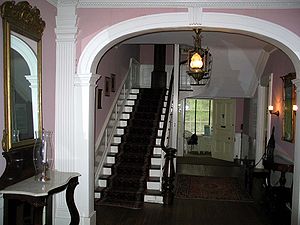
After the Lees
Upon the death of Mrs. Fleming in 1903, the house was to be sold to settle her estate. However, Myra loved the house so much that she threatened to burn it down with herself in it if it were sold out of the Lee family. As a result of her worrying, she was put into a hospital. In the meantime, Myra’s mother went to Myra’s best friend, Mai Greenwell, and asked her to buy the house. At the time she had a house that she was content with, and had no plans to purchase the Lee-Fendall House. However, a suitor was at the meeting, and upon hearing this, told Mai if she would marry him, he would buy the house. The suitor was Robert Forsyth Downham, who bought the house for $5,500, thus ending the Lee family’s control of the structure. The couple lived here until 1937. Between 1785 and 1903, the house had been lived in by 37 members of the Lee family.
John L. Lewis
John Llewellyn Lewis was an American leader of organized labor who served as president of the United Mine Workers of America from 1920 to 1960...
, president of the United Mine Workers
United Mine Workers
The United Mine Workers of America is a North American labor union best known for representing coal miners and coal technicians. Today, the Union also represents health care workers, truck drivers, manufacturing workers and public employees in the United States and Canada...
. During the next 32 years, the house was the home of Lewis, his daughter Katherine and his wife Myrta. Lewis started life as a coal miner in Iowa
Iowa
Iowa is a state located in the Midwestern United States, an area often referred to as the "American Heartland". It derives its name from the Ioway people, one of the many American Indian tribes that occupied the state at the time of European exploration. Iowa was a part of the French colony of New...
and quickly worked his way up the union ranks to be president of the United Mine Workers of America for over four decades. He moved the headquarters of the UMWA to Washington, DC to be closer to the people in power. As president of the UMWA, he increased wages by ten times, started the first safety regulations in the mines, and started health care facilities where there weren't any before. He was also one of the founders of the AFL-CIO
AFL-CIO
The American Federation of Labor and Congress of Industrial Organizations, commonly AFL–CIO, is a national trade union center, the largest federation of unions in the United States, made up of 56 national and international unions, together representing more than 11 million workers...
. To do all this, he defied two presidents, Franklin Delano Roosevelt and Harry S. Truman
Harry S. Truman
Harry S. Truman was the 33rd President of the United States . As President Franklin D. Roosevelt's third vice president and the 34th Vice President of the United States , he succeeded to the presidency on April 12, 1945, when President Roosevelt died less than three months after beginning his...
, and pulled the miners out on strike in the middle of World War II
World War II
World War II, or the Second World War , was a global conflict lasting from 1939 to 1945, involving most of the world's nations—including all of the great powers—eventually forming two opposing military alliances: the Allies and the Axis...
, causing a major energy shortage. During the strike, Lewis was strung up in effigy at the corner of Washington and Oronoco, outside his home, as a traitor for hurting the war effort so much. After Lewis died in 1969, the Lee-Fendall House was leased until 1974, when it was purchased by the Virginia Trust for Historic Preservation. From that time to the present, it has become a well-known Virginia landmark and was placed on the National Register of Historic Places
National Register of Historic Places
The National Register of Historic Places is the United States government's official list of districts, sites, buildings, structures, and objects deemed worthy of preservation...
in 1979. The Lee-Fendall House serves not only as an educational historic house museum but also as the setting for weddings and gala social affairs.
External links
- Lee-Fendall House Museum And Garden Website
- Official website of Stratford Hall
- http://en.wikipedia.org/w/index.php?title=Lee-Fendall_House&action=edit§ion=3

